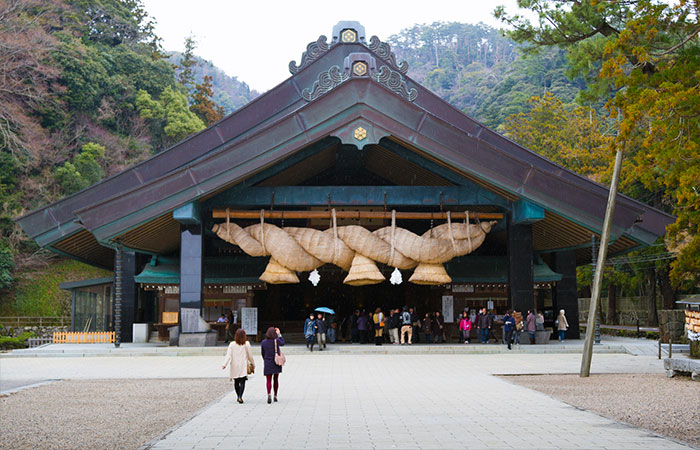Western Honshu

Also known as Chugoku, meaning "middle country", WESTERN HONSHU used to be at the centre of the Japanese nation, lying between the country's earliest settlements in Kyushu and the imperial city of Kyoto. The region is split geographically into two distinct areas. The southern San'yo coast is blighted by heavy industry but borders the enchanting Inland Sea, while the rugged and sparsely populated northern San'in coast boasts some delightful small towns and a generally pristine landscape. The southern coast is easy to travel around, with Shinkansen lines, good local railway services and highways, while the northern coast takes more planning to tour by public transport, but easily repays the effort.
Okayama, 1 hr. by Shinkansen super express from Shin-Osaka, is a gateway to the Chugoku region and Shikoku Island. The main attraction here is the Korakuen Garden. Filled with flowers all year round, this garden masterpiece was created in 1700 by the ruling feudal lord of the Okayama clan who spent 14 long years to complete it.
Tsuwano, hauntingly beautiful town, tucked into a narrow north-south valley at the foot of conical Aono-yama and its attendant dormant volcanic mountain friends, may be the most picturesque hamlet in all Japan. If you catch it on a clear day, the view from the old castle ruins simply takes your breath away. Even when it's cloudy, the mist hangs romantically among the trees and ridges. The stucco-and-tile walls hearken back to ancient times, like those in Hagi and Kurashiki, and the clear, carp-filled streams running beside the streets can induce even tired, jaded travellers to take a leisurely stroll or bike ride backward through time.

Okayama Castle

Korakuen Garden Okayama

Tsuwano

Yabusame Event Tsuwano
Hiroshima, a former castle town, is reached in 1hr. 40min. by Shinkansen super express from Shin-Osaka. The present city emerged from the ashes of the World War II atomic bombing. Peace Memorial Park contains the Peace Memorial Museum displaying a large collection of photographs and objects relating to the devastation. Here the Peace Flame burns in front of the Memorial Cenotaph, never to be extinguished until all nuclear weapons are abolished.
Twenty-five min. by train from Hiroshima and a 10-min. boat ride from Miyajima-guchi, takes you to Miyajima Island and Itsukushima Shrine, a must-see for all. The entire island, with an area of 30 sq. km., is designated by the government as a Special Historic Site and a Special Place of Scenic Beauty. The shrine buildings are connected by corridors which stretch out over the water, so at high tide the whole structure appears to be floating on the sea. A red camphor wood torii gate rising out of the sea is the landmark of the shrine. Many colourful festivals are held here throughout the year, but the most dramatic is Kangen-sai in July or August. On this occasion, the Itsukushima deity is taken on a boat journey to visit other shrines on the mainland side and back. Sacred music is played on ancient Japanese instruments.
Hagi (Higashi-Hagi Sta.), 1 hr. 10 min. by bus from Shin-Yamaguchi Sta., is an old castle town rich in history. Hagi is the birthplace of many prominent samurai who led events resulting in the Meiji Restoration. A number of old-time samurai residences, temples and shrines can be found here and there around the town, which exudes a calm, and tasteful atmosphere. Just touring the peaceful lanes is an enjoyable experience.

Hiroshima Cenotaph

Miyajima Island Torii

Itsukushima Shrine

Tokoji Temple Hagi
Tottori, 4 hrs. 20 min. by limited express from Osaka, is the seat of Tottori Prefecture. The city is noted for the sand dunes located 5 km. to the north in a portion of the San-in Kaigan National Park. Visit the dunes early in the morning to discover the beautiful patterns on their surfaces created by winds and rain during the night.
Matsue, 2 hrs. from Tottori by limited express, is situated at the point where the Nakaumi Lagoon joins Lake Shinji. The city is a major distribution hub and tourist destination, as well as the seat of Shimane Prefecture.
Izumo Taisha Shrine, 10 min. by train from Izumoshi Sta., is famed for its architectural style and is one of the oldest shrines in Japan. Backed by history stretching a few thousand years, the grand sanctuary building stands in its own solemn splendour. The deity enshrined here is famous nationwide in support of marital bliss, thus attracting large numbers of young woman worshippers.

Tottori Sand Dunes

Matsue Castle

Lake Shinji Sunset







